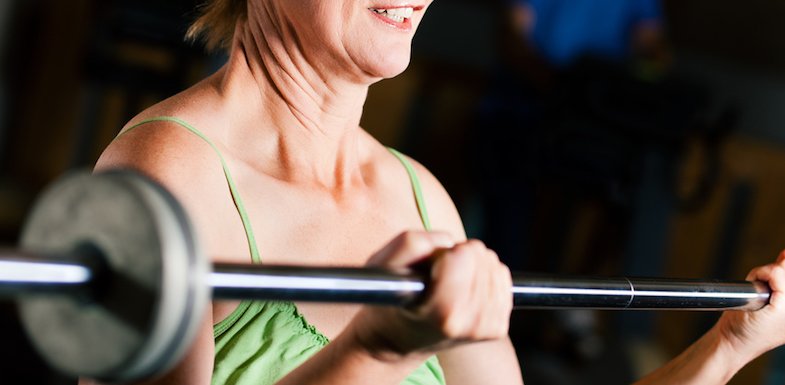
Bones are living tissue and, because of this, the body is constantly absorbing and replacing minerals from bones. When the body begins to absorb minerals faster than it can replace them, bone density decreases. This decrease in bone density can lead to osteoporosis, which literally means “porous bone.” Here’s what you should know about osteoporosis prevention and early detection.
What is osteoporosis?
Osteoporosis causes bones to become brittle, which means that there is a greatly increased risk of broken bones, especially hips. 40 million people in the United States either have osteoporosis already or are at high risk of developing it. According to an article published in the McGill Journal of Medicine, as many as 250,000 hip fractures are attributed to osteoporosis each year in the United States.
Bones are living structures in our bodies, and up until around age 35 they are actively growing and getting stronger. Although bones continue to grow for nearly our entire lives, after age 35, bones begin to deteriorate. Once deterioration occurs at a faster rate than bone growth, osteoporosis can develop. Bones develop pockets that cause weakness and can eventually lead to fracture from just a little pressure. The key to managing osteoporosis is focusing on early prevention, correct diagnosis, and proper treatment.
There are often no symptoms associated with early osteoporosis, and later symptoms can be subtle enough to ignore. Because of this, many people don’t realize they have osteoporosis until a bump, strain, or fall causes a broken bone. Therefore, it’s important to be aware of the risk factors for osteoporosis.
Osteoporosis risk factors
The major osteoporosis risk factors include:
- Gender: Women are much more likely to develop osteoporosis
- Age: Women over 50 and men over 70 are at higher risk
- Ethnicity: Osteoporosis is more common among Caucasian and Asian women
- Family history: Osteoporosis often runs in families
- Frame size: People with smaller frame sizes are at a higher risk, because they have less bone mass to begin with
If you have multiple risk factors, your doctor might suggest a bone density test. This is also called a bone scan. Even if the patient is not diagnosed with osteoporosis as a result of the bone scan, it’s possible the test might show a lowered bone density. This means a higher risk for osteoporosis later on. Knowing that a patient is at risk for osteoporosis can allow his or her physician to suggest therapies or medications to slow or stop the onset of osteoporosis.
What are the basics of osteoporosis prevention?
The most effective way to prevent osteoporosis is to maintain a healthy lifestyle during the first two decades of life by eating a nutrient-rich diet and exercising regularly. However, it’s never too late to make lifestyle changes to reduce the risk of osteoporosis.
For example, avoiding tobacco use and excessive alcohol is highly recommended, since both can both weaken bones and lead to osteoporosis. Here’s some ways to practice osteoporosis prevention, both before you’re diagnosed and how to manage symptoms if you are.
Eat a healthy diet that’s rich in calcium
A healthy diet is key to osteoporosis prevention. It’s recommended that the average adult get around 1,000 mg of calcium every day, although women over 50 and men over 70 should get about 1,200 mg. When the body doesn’t have enough calcium to function, it takes calcium from the bones, leading to decreased bone density and osteoporosis. The National Institutes of Health provide a table of recommended calcium intake for different populations.
The body also needs vitamin D because it aids in the absorption of calcium. Vitamin D from the sun can be absorbed through the skin, or it can be obtained through diet. Foods like egg yolks, liver, saltwater fish, and fortified dairy products are rich in vitamin D. If needed, there are also supplements available that provide both calcium and vitamin D.
Practice strengthening exercises
Exercises that strengthen the muscles will also strengthen the bones, which can prevent or slow the onset of osteoporosis.
Activities like running, jogging, dancing, or jumping rope can strengthen bones, but these are all quite high-impact and more appropriate for those who do not have any loss of bone density.
If a patient has already been diagnosed with lowered bone density or osteoporosis, high-impact exercises could cause bone fractures. Therefore, low-impact exercises such as using an elliptical or stair-step machine, practicing gentle aerobics, or walking can be beneficial for patients with osteoporosis.

Avoid falls
Another simple but very important way of preventing broken bones is to avoid falling. The people most at risk for osteoporosis are seniors and the elderly. This population is also, unfortunately, more likely to have impaired balance, sight, and strength. And, this can lead to falls.
Simple preventative measures include:
- Moving electrical cords
- Having proper lighting
- Putting salt on ice in the winter
A broken hip can be extremely detrimental to a patient’s quality of life and, in some cases, can even lead to death. Because the hip is so necessary to movement, a broken hip can interfere with the ability to take part in everyday activities.
Many seniors who break a hip are unable to care for themselves afterwards and must turn to long-term nursing care. Additionally, as many as 20% of seniors who break a hip will die within a year. This may be because of conditions related to the broken bone or the surgery to repair the broken bone.
Get tested if you’re at risk
Key to managing osteoporosis is proper diagnosis. This may seem straightforward (go to the doctor, get screened, get a diagnosis), but research from the University of California Davis Health System has found that osteoporosis screenings aren’t targeting the highest risk populations.
The screening records of 51,000 women who were between the ages of 40 and 85 and received health care in the Sacramento region were examined over a seven-year period. Physician and study lead Anna Lee Amarnath found that 42% of eligible women between the ages of 65 and 74 and 57% of women over 75 were not screened. This was true even when these women were at risk and screening was warranted.
Conversely, 46% of low-risk women between 50 and 59 and 59% of those between 60 and 64 were screened for osteoporosis without cause. Amarnath and her team believe this lopsided screening was caused by one primary factor: the timing of menopause.
Most doctors begin to think of osteoporosis risk for their patients when they enter menopause, typically around 50 years of age. Thus, screenings tend to occur at that time. The U.S. Preventive Services Task Force recommends that osteoporosis screenings occur after age 65 unless risk factors are present, but the behavior of doctors in this large study suggests that recommendation is not being followed.
Osteoporosis prevention for men
Another population that is typically ignored in osteoporosis screening is men. Although two million men in the U.S. have osteoporosis, with an estimated eight to 13 million more with low bone density, the majority of men avoid osteoporosis screenings.
What is most troubling about these findings is that although men are typically less affected by osteoporosis, when they do have it and suffer a hip fracture because of it, they are twice as likely to die as women. Men are also more likely to lose their independence after a fracture than women and require more post-fracture care.
Managing osteoporosis pain
If you do suffer a fall or break from osteoporosis, it can lead to ongoing chronic pain. For a successful recovery, it’s important to regain mobility and resume normal day to day activities as soon as possible. To assist in this, there are various pain-management techniques that can alleviate discomfort or pain.
Because stronger muscles provide better protection from broken bones, it’s important for patients with osteoporosis to talk to their physicians about pain management techniques, as well as strengthening exercises that are appropriate for them.
Non-steroidal anti-inflammatory medications (NSAIDs) are effective for reducing inflammation, thereby lessening discomfort.
Alternatively, the patient’s physician may recommend a spinal nerve block injection. This injection is a pain medication, like lidocaine or mepivacaine, that is delivered directly to the affected spinal nerve. A similar procedure called a hip joint injection is the insertion of anesthetics directly into the hip joint. Both a spinal nerve block and a hip joint injection might also contain corticosteroids to reduce inflammation.
Another type of pain management therapy involves electric currents. Transcutaneous electric nerve stimulation (TENS) is the placement of small pads or a cap on the affected area. Electrical impulses are delivered that block pain signals along the nerves. TENS has received support as an effective pain management treatment, that is also very low-risk.
Get help
Osteoporosis fracture increase the risk of premature death. It is important to follow screening guidelines and treatment protocols, regardless of gender. Osteoporosis prevention starts now, no matter what age you are. If you may be at risk for osteoporosis, talk to your doctor about screening and treatment options.